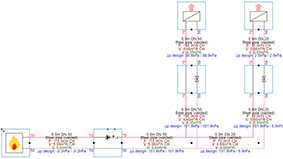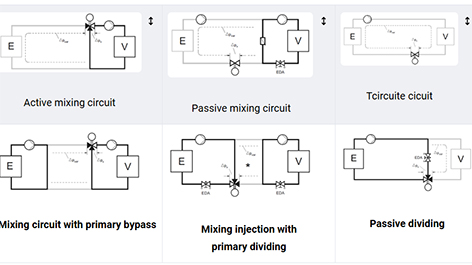Why Chilled Water Systems Often Underperform
Many chilled water installations are sized using a static “design point” method: peak cooling load, fixed flow and constant ΔT. But actual operation rarely stays at that point. As loads drop, flow reduces, valves modulate and temperature differences shift. A good example is partial load analysis — the flow rates change significantly when only some valves open or pumps reduce speed.
If a system uses standard sizing without simulating that varying behaviour, issues emerge: poor ΔT, over-pumping, thermal imbalance and comfort complaints. Static calculations cannot predict how the plant behaves when many circuits throttle back or the building enters a mild season.
The Role of Pumping, Control and Flow Variation
In chilled water systems with variable flow, the pump and control strategy must align with real operation. A pump may operate well at full load but inefficiently at 50 % flow if it isn’t sized for that condition. The pump curve shows how head and flow vary — failure to use it means the pump might sit outside its efficient zone for much of its life.
Control strategies such as differential pressure control or variable-speed drive respond to changing loads, but they need accurate modelling of how pipe resistance, valve lift and flow distribution evolve. Without this, you risk valves passing too much water (thus reducing ΔT), or pumps chasing changing pressure demands and wasting energy.
Why System-Level Simulation Makes the Difference
Dynamic simulation allows engineers to model the chilled water system over time, not just at one condition. Using dynamic simulation, one can observe how the system reacts when parts of the network shut down, when outside temperature changes, or when setpoints shift.
This reveals hidden behaviours such as:
- flow bypassing less resistant branches and starving others;
- pump shifting to low efficiency zones as system curve changes;
- reduced ΔT at part load, increasing chiller runtime and energy use;
- control instability when multiple pumps and valves interact.
By simulating full-year behaviour, engineers can size pumps and valves correctly, choose suitable control logic and ensure the system maintains performance throughout the year — not just at peak.
Practical Steps for Better Chilled Water System Performance
- Model the system across full operational range, not only peak load;
- Use actual component curves and control logic in your model;
- Ensure valve sizing and authority remain stable under part-load;
- Verify that pumps operate along efficient part of their curve throughout the year;
- Balance circuits hydraulically so flow redistribution under part-load doesn’t cause issues.
When these aspects are addressed, chilled water systems deliver consistent comfort, maintain ΔT, reduce energy use and avoid surprises in operation.
FAQ: Dynamic Simulation for Chilled Water Systems




